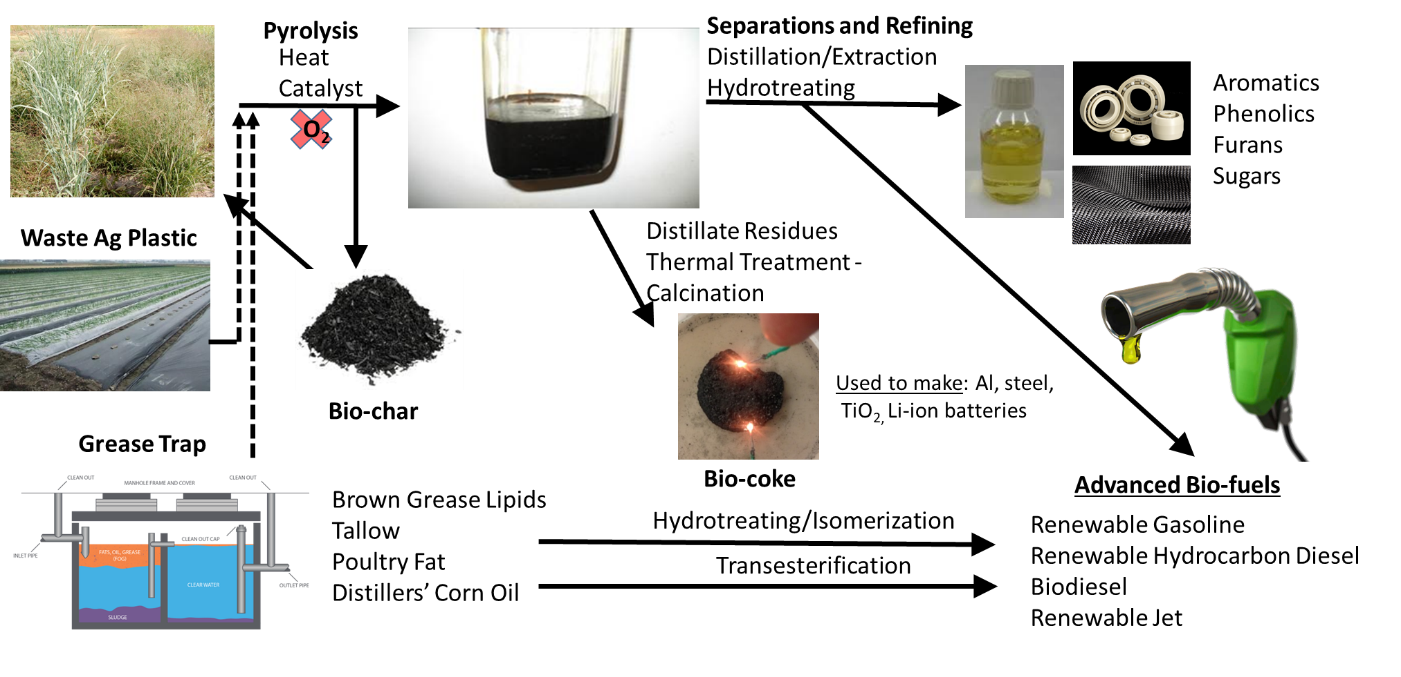| What is Pyrolysis? |

|

Introduction Our Research What Is Pyrolysis? Bio-Oil Researchers
Facilities Our Partners Publications In The News Links
What Is Pyrolysis?
Biomass
Lignocellulosic biomass is the most abundant renewable carbon source on Earth. Available biomass sources include forest residues, crop residues, purpose grown energy crops (e.g. grasses), animal wastes and food wastes. These materials are the fibrous structural parts of plants and are largely made of cellulose, hemicellulose and lignin. Compared with so called 1st generation bio-feedstocks such as sugars, starches and vegetable oils, nature has made these parts of the plants difficult to deconstruct to chemical building blocks, making utilization of this carbon source a challenge for scientists and engineers. Biorefineries are facilities where biomass is converted to a variety of products. Our target products included advanced hydrocarbon biofuels that are indistinguishable from fossil-based gasoline, diesel or jet fuels along with bio-based chemicals and materials. Technologies need to be developed to more efficiently convert this renewable carbon source so that renewable bio-products from biomass can be made economically competitive with those produced from fossil resources.
Pyrolysis
Pyrolysis is one of the technologies available to convert biomass to an intermediate liquid product that can be refined to drop-in hydrocarbon biofuels, oxygenated fuel additives and petrochemical replacements. Pyrolysis is the heating of an organic material, such as biomass, in the absence of oxygen. Biomass pyrolysis is usually conducted at or above 500 °C, providing enough heat to deconstruct the strong bio-polymers mentioned above. Because no oxygen is present combustion does not occur, rather the biomass thermally decomposes into combustible gases and bio-char. Most of these combustible gases can be condensed into a combustible liquid, called pyrolysis oil (bio-oil), though there are some permanent gases (CO2, CO, H2, light hydrocarbons), some of which can be combusted to provide the heat for the process. Thus, pyrolysis of biomass produces three products: one liquid, bio-oil, one solid, bio-char and one gaseous, syngas. The proportion of these products depends on several factors including the composition of the feedstock and process parameters. However, all things being equal, the yield of bio-oil is optimized when the pyrolysis temperature is around 500 °C and the heating rate is high (1000 °C/s) fast pyrolysis conditions. Under these conditions, bio-oil yields of 60-70 wt% of can be achieved from a typical biomass feedstock, with 15-25 wt% yields of bio-char. The remaining 10-15 wt% is syngas. Processes that use slower heating rates are called slow pyrolysis and bio-char is usually the major product of such processes. The pyrolysis process can be self-sustained, as combustion of the syngas and a portion of bio-oil or bio-char can provide all the necessary energy to drive the reaction.

Schematic of the Fast Pyrolysis Process.
Bio-oil is a dense complex mixture of oxygenated organic compounds. It has a fuel value that is generally 50 - 70% that of petroleum bases fuels and can be used as boiler fuel or upgraded to renewable transportation fuels. The bio-oil’s composition makes it thermally unstable and therefore difficult to distill or further refine, making additional research on producing higher quality bio-oil necessary. However, its density is > 1 kg L-1, much greater than that of biomass feedstocks, making it more cost effective to transport than biomass. Therefore, it’s is possible to envision a distributed processing model where many small scale pyrolyzers (farm scale) covert biomass to bio-oil which is then transported to a centralized location for refining. To test this hypothesis, our group developed and constructed a mobile one-ton per day pyrolysis demonstration unit based on a reactor design called the combustion reduction integrated pyrolysis system (CRIPS). The CRIPS unit can produce bio-oil on location and can perform fast or catalytic pyrolysis to produce partially deoxygenated bio-oil.
 ARS’s Mobile Combustion Reduction Integrated Pyrolysis System (CRIPS)
ARS’s Mobile Combustion Reduction Integrated Pyrolysis System (CRIPS)
Furthermore, the bio-char produced can be used on the farm as an excellent soil amender that can sequester carbon. Bio-char is highly absorbent and therefore increases the soil's ability to retain water, nutrients and agricultural chemicals, preventing water contamination and soil erosion. Soil application of bio-char may enhance both soil quality and be an effective means of sequestering large amounts of carbon. Use of bio-char as a soil amendment will offset many of the problems associated with removing crop residues from the land.
Our Project
Our core project at the Eastern Regional Research Center current has four main objectives dedicated to making pyrolysis and biodiesel based biorefineries economically competitive. They include:
- Develop thermochemical and/or catalytic, carbon efficient biomass and waste plastic conversion processes to produce bio-oils and bio-gas containing fractions suitable for use towards advanced commercially viable bio-fuels (jet, diesel, and gasoline carbon ranges).
- Develop pre- and post-process thermo-catalytic technologies to produce renewable chemicals and biocarbon materials from biomass, biochar, lignin and bio-oils.
- Identify and develop new feedstocks and technologies to produce biodiesel, renewable hydrocarbon diesel and biojet fuels from fats and oils.
- Accurately estimate the economic values of thermolysis conversion processes to produce bio-based fuels and chemicals.

Our approach to developing commercially viable pyrolysis based biorefineries is summarized in the Figure above. We are developing catalytic pyrolysis technologies where a catalyst is used to reduce the oxygen content of the bio-oil to produce stable, low or mid-level oxygen content bio-oil that can undergo separation processes such as distillation to sperate fractions to be used for various refining processes to produce renewable chemicals in addition to biofuels. We are also developing replacements for fossil based industrial carbons such as coke and pitch that can be used in heavy carbon emitting industries such as aluminum smelting. Furthermore, we are tackling the plastic waste problem by considering waste plastic, especially the very common polyolefins, as a potential source of cheap hydrogen making up for the inherent hydrogen deficiency in biomass. Our preliminary results indicate that co-pyrolysis of biomass with plastic waste over a catalyst can increase the carbon conversion efficiency to valuable aromatic hydrocarbons.
